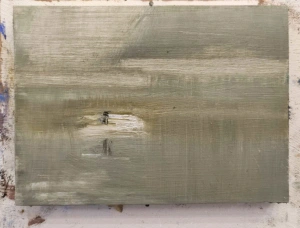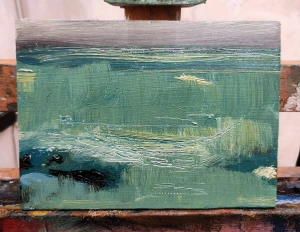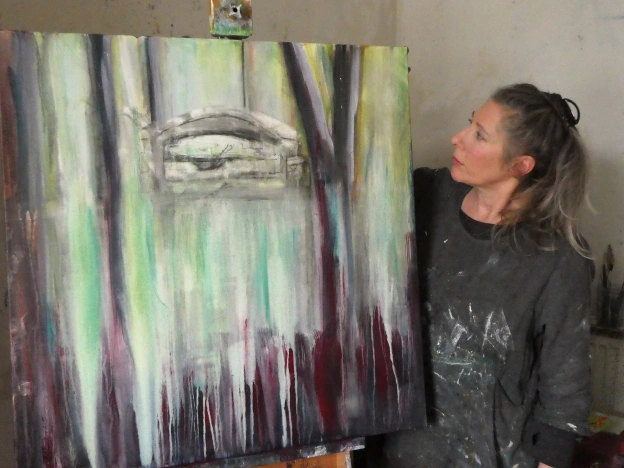
A little video …
Above: Today’s studio shot – Return. VI. Mixed media on 32×32″ canvas. Rose Strang 2024
At the weekend I visited the Crusader’s effigy at Aberlady again with a posse of young relatives including my niece Emma and her partner Manuel, who had fun editing this atmospheric video in about ten minutes from just a couple of minutes of footage!
(His website is called Strength in Motion or follow his work here on – Instagram)
If you’ve been intrigued by this project I think you’ll enjoy this!
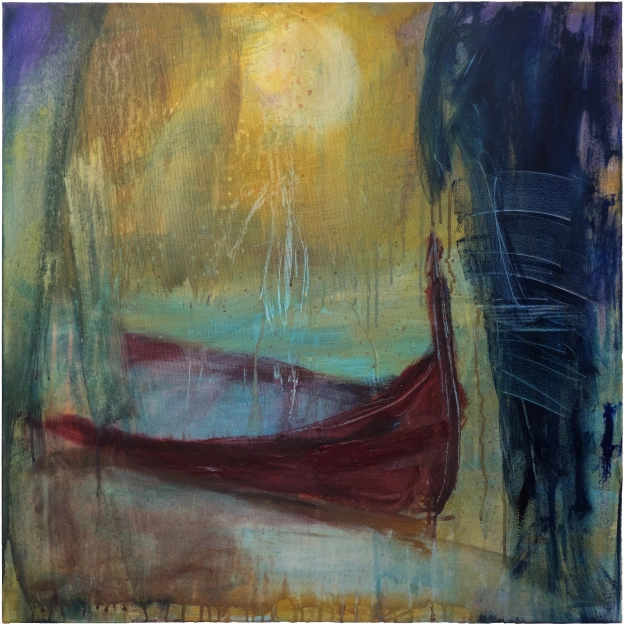
Return (crusader’s effigy) day 7
Painting in progress (above, and below on the easel): Return III. Acrylic and oils on 32×32″ canvas. Rose Strang 2024

Today’s painting which explores many ideas related to the landscape of Aberlady and the effigy of a 13th century crusader that forms part of a ruined friary near the village. This one’s a bit more in keeping with my original theme than yesterday’s painting
I enjoyed going off in new directions yesterday, but there’s an atmosphere surrounding this series that I want to get across – basically how it feels to stand in front of this mysterious place hidden in the forests of Aberlady. Also I’m exploring the ideas that have taken both my painting and my imagination on a journey. At times it’s helped me contemplate a difficult subject – namely the ‘Holy war’ as it was titled in the middle ages.
Here are a couple of photos from our trip to the Carmelite friary at the weekend …

Return (Crusdaer’s effigy) day 6
Above, another iteration of the ‘Return’ theme. Featuring the stylised effigy of a crusader from the 12th century, as discovered at a ruined Carmelite Friary in Aberlady.
Not the title I’ll give it, obviously! This one is in progress and I’m interested to see a sort of formal hall emerge. Or perhaps with new colours it’ll turn into a stately forest …

A beautiful place …
Above: Beauly substation.
What you see above is a view of the gravel quarry and SSEN (Scottish and Southern Electricity Networks) electricity substation near Beauly, Inverness-shire.
Beauly means ‘a beautiful place’ and despite these developments by SSEN, much of it still is. We were walking there again last weekend as part of a visit to the Kilmorack Gallery (showing the excellent exhibition Borrowed Land until 2nd March)
For perspective, here’s an old map of the area contrasted with a current view …
It’s pretty disheartening isn’t it? Imagine if you lived here though, and your favourite walk, through landscape like this (my photos of Beauly taken last weekend and last November) …
Was replaced with this …
The site includes numerous important archeological remains and the developments have obviously caused utter devastation to local wildlife.
SSEN (Scottish and Southern Electric Network) plan to extend their transmission line, create more wind farms and, the site at Beauly is to be extended from 60 acres to 860 acres, which is just huge.
Even worse, this is intended for areas across the Scottish Highlands …

Some might consider this the inevitable price of progress, but it’s not progress, and nor is it needed – which becomes very evident when you look into current and future energy requirements for Scotland and the UK. As usual, quite simply it’s a money-making excercise for global companies, supported and encouraged by our own government.
I’ll include more information about SSEN’s proposals ongoing, but I’m new to this and you’ll be better informed about these developments and possible ways to help by joining this facebook page…
Communities Before Power Companies
It’s run by people who live in these areas who’ve been resisting such developments for years. If/when you join, invite all your contacts and remember that this affects us all -you might not be able to attend local meetings, but you can sign petitions, write to MP’s and share information.
Lastly, here are two excellent letters/articles published by the Press and Journal (by two admins for Communities Before Power Companies) Elaine Ritter and Denise Davis …
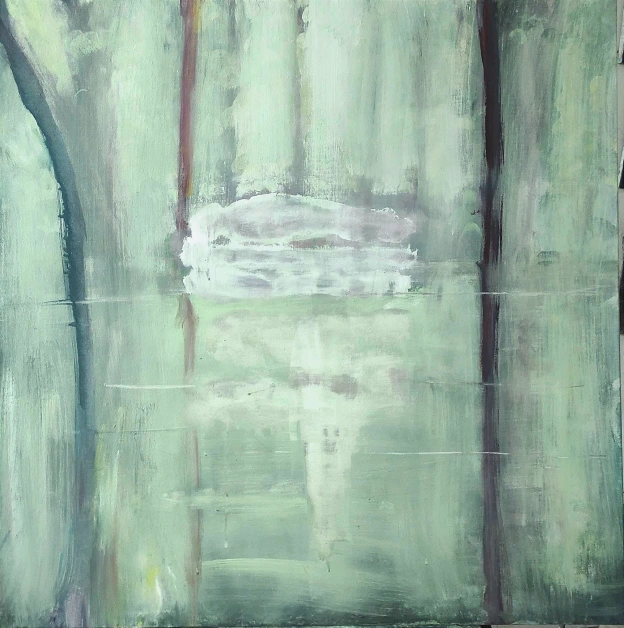
Return (Crusader’s effigy) series, day 6
Above Return II. Acrylic on 32×32″ canvas. Rose Strang 2024.
Just a quick post today with an image of today’s painting, which is a perhaps more resolved version of yesterday’s composition (below)

I was halfway through writing a blog post about the SSEN’s plans to set up sub stations throughout Scotland, which will ruin the landscape not to mention the happiness and livelihoods of locals to these areas. I want to do the subject justice though, and to provide information so people can actually add to protests.I hope to post it tomorrow afternoon.
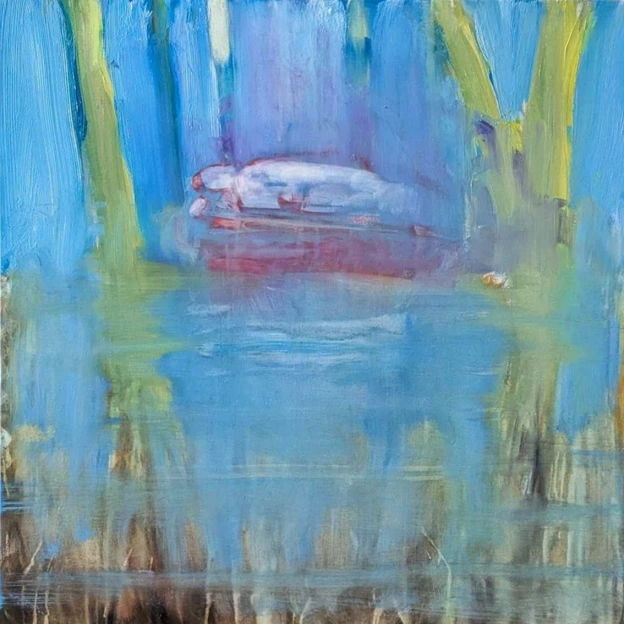
Crusader’s tomb day 5
Above Return. Acrylic on 31.5×31.5 ” canvas. Rose Strang 2024
Photo below to show scale …
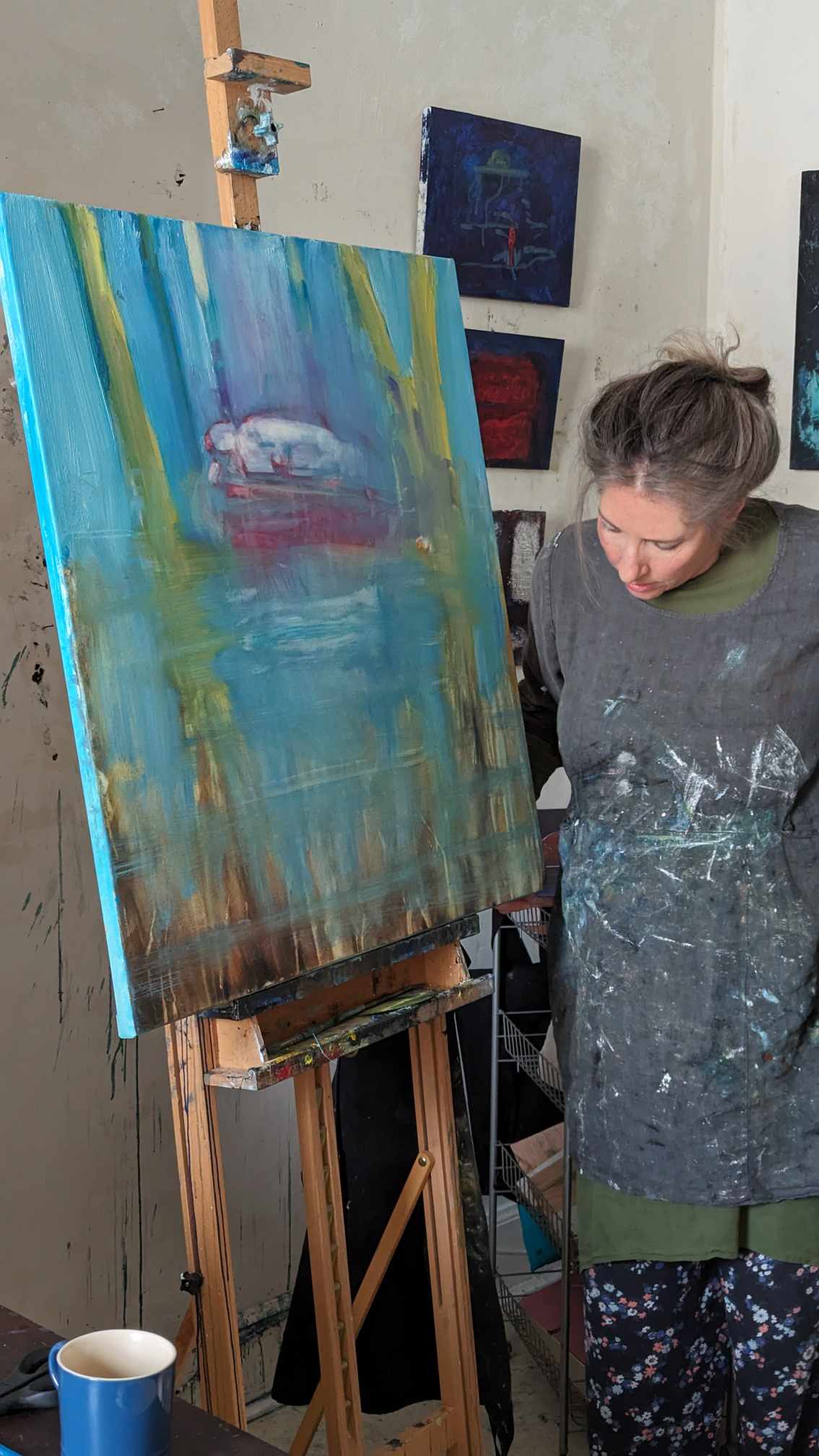
Moving on to larger canvas today, I’m feeling happy with the direction this series is taking.
I was calling this the ‘crusader’s tomb’ series but I feel that the title ‘Return’ has more resonance and is less restricting somehow, though I am inspired by the crusader’s tomb and effigy near Aberlady.
Recently I’ve felt that I’m truly finding my way as an artist after decades of exploring, and it’s good to discover that I have a theme to which I return again and again, which is – the traces of past cultures on landscape. A few days ago I finished reading a book called ‘Elixir‘ by the Bulgarian author Kapka Kassabova (who now lives in Inverness-shire, Scotland). In the book she describes her return to the Mesta valley in Bulgaria and her growing awareness of its layers of history:
But it’s all still here, the house whispered, this is not the end. They wanted me to know this. What you think is here is only the surface view of something deeper that runs through us like electricity through the air, the house wanted me to know. Beams that in a flash illuminate the valley and its breathing creatures. Then darkness again.
I’m far from alone in my feeling that these voices, memories and traces of the past are profoundly important – and that we’re only partially aware of what’s at stake. I’m not talking about climate change as such, but in particular our relationship with landscape and each other.
It’s interesting to speculate on what David de Lindsey might say if he could speak to us. He was desparate for his remains to be returned to the landscape he loved, and his direct descendants honoured his dying wishes – money was left not just for the founding of a Carmelite Friary at Aberlady, but also for the community it served – their livelihood and landscape. Is it this energy I sense when standing in the ruins of the Friary? Probably it’s just imagination, but then what is imagination for?
In my next blog I want to share information about the destruction of beautiful areas of the Scottish Highlands, including parts of Beauly in Inverness-Shire. Right next door in fact to the Kilmorack Gallery where I’ve been showing my three works from the Trace series as part of the Borrowed Land exhibition, which incidentally closes on the 2nd March, so go and have a look while you can!

More oil sketches …
Above: Shorelines, Aberlady. I. Oil on 8×5.5″ wood. Rose Strang 2024
More oil sketches in progress today inspired by the shorelines and moods of Aberlady…
For my experimental paintings and ideas I’ve been working at this size for some time and it really works for me in terms of loose brushwork. It would be a bit of a nightmare to work at a larger size with this more experimental messy approach – that would be a lot of oil paint going to waste when it doesn’t work (which is often!) and a lot of physical energy and time expended.
It’s been a while since I posted a video of my working process. I’m very forgetful of such things but people seem to enjoy them, so one of those coming up soon.
I’m also still working on my Carmelite monastery and Crusader’s tomb series (see older posts) which are very different in feel to these smaller landscape paintings. I love the freedom of my smaller landscape paintings, but I think I have something more to say as an artist so I’ll be persevering with that series over the coming weeks. It’s important to get out of my comfort zone and dig a bit deeper …
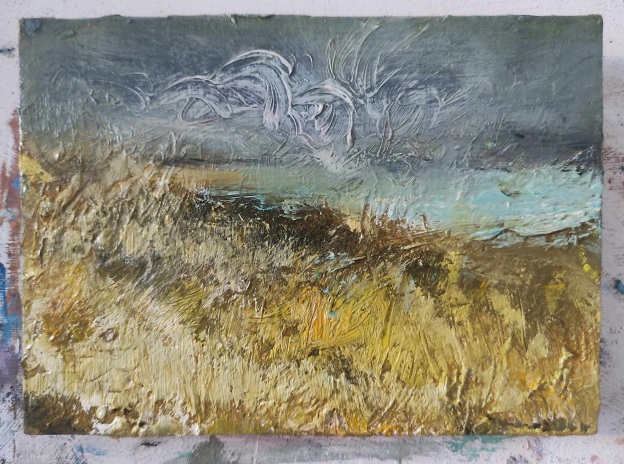
Oil sketches …
Above: Aberlefdi. Winter I. Oil on 8×5.5″ wood. Rose Strang 2024
These are some oil sketches I’ve been working on as part of a general series this year which explores the history and landscape of Aberlady in the south of Scotland.
Part of the series is a deeper look at the the history of a Carmelite monastery near Aberlady, but the paintings also reflect my love of a landscape that’s deeply familar to me.
I think there’s something dreamlike about Aberlady. It might be the sheer sense of space in sky, sand and sea, but I think it’s also something I find in particular on the east coast of Scotland. Looking out to the north sea towards Norway and Denmark, there’s something haunting about the fact that about 8000 years ago we’d have been looking at Doggerland, before the series of great landslides called the Storegga Slides occurred, creating the north sea. It looks and feels very different to the soft light of the west coast of Scotland.
Whenever I look at paths or horizons in this landscape, I also think of journeys, and the fact that not so long ago in the days when Aberlady was called Aberlefdi (hence the title of this series of small landscapes) it was an important stop on the pilgrim route between the Isle of Iona and Lindisfarne, or Holy Isle as it’s also known. That was in around 700AD when one of St Columba’s followers called St Aiden was tasked with setting up a new monastery on Lindisfarne.
When you camp over night near Aberlady you experience all the moods of the seasons; the burnished gold of marram grass and sand in winter, the soft green of the sea and grass in June when the larks and rabbits are at their busiest, or the thunder, lightning and rainstorms on humid late summer nights.

Crusader’s tomb day 4
Above: Island. Acrylic and oil on 14×10″ wood. Rose Strang 2024
This is one of today’s paintings as part of the Crusader’s tomb series I’m working on this year. (previous posts here – post 1
I imagined our crusader, David de Lindsey visualising his home, as he lay in bed being looked after by Carmelite monks in the Middle East . He might dream of the landscape he’d pass on his voyage back to Scotland and Luffness, so the painting above is a sort of Bass Rock of the mind. It’s an island anyone entering the Firth of Forth would see as they sailed past.
I’m working on this series intuitively, allowing imagery to surface as it wishes. Here are two more paintings in progress from today’s session in the studio –
- ‘Abyss’. Oil on 20×20″ canvas. Rose Strang 2024
- ‘Seal’. Oil on 10×8.5″ wood. Rose Strang 2024
I’m exploring the traumatic side of de Lindsey’s experience, the painting above shows a quickly sketched copy of the danse macabre on red background from a Medieval painting. Underneath is the faint suggestion of a horse – a romanticised image associated with crusaders. The colour of the red oil paint also makes me think of a wax seal – a promise or signed contract maybe.
I’m using these images I suppose to explore the way we’re drawn to causes through powerful imagery. We’re such visual people and I wonder if those with visual impairments are less susceptible to (for example) political campaigns since they can’t see slogans and imagery!
At the same time the imagery I’m choosing is a way to say something about the idea of faith and the spirit, because we do share archetypal images in imagination, so the image above the red painting directly above might suggest spirit, and it echoes yesterday’s painting. Return II
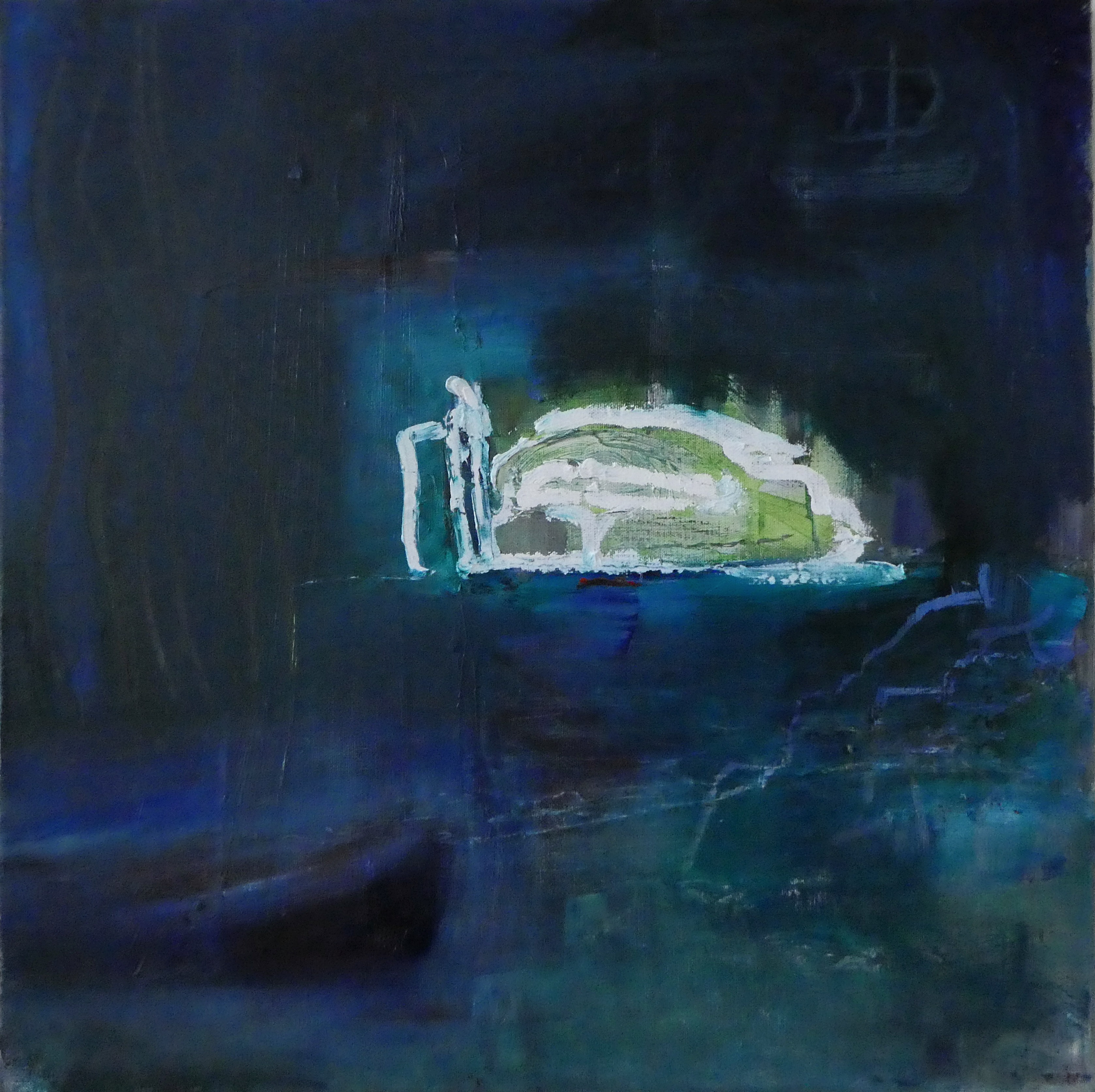
More paintings soon …





















